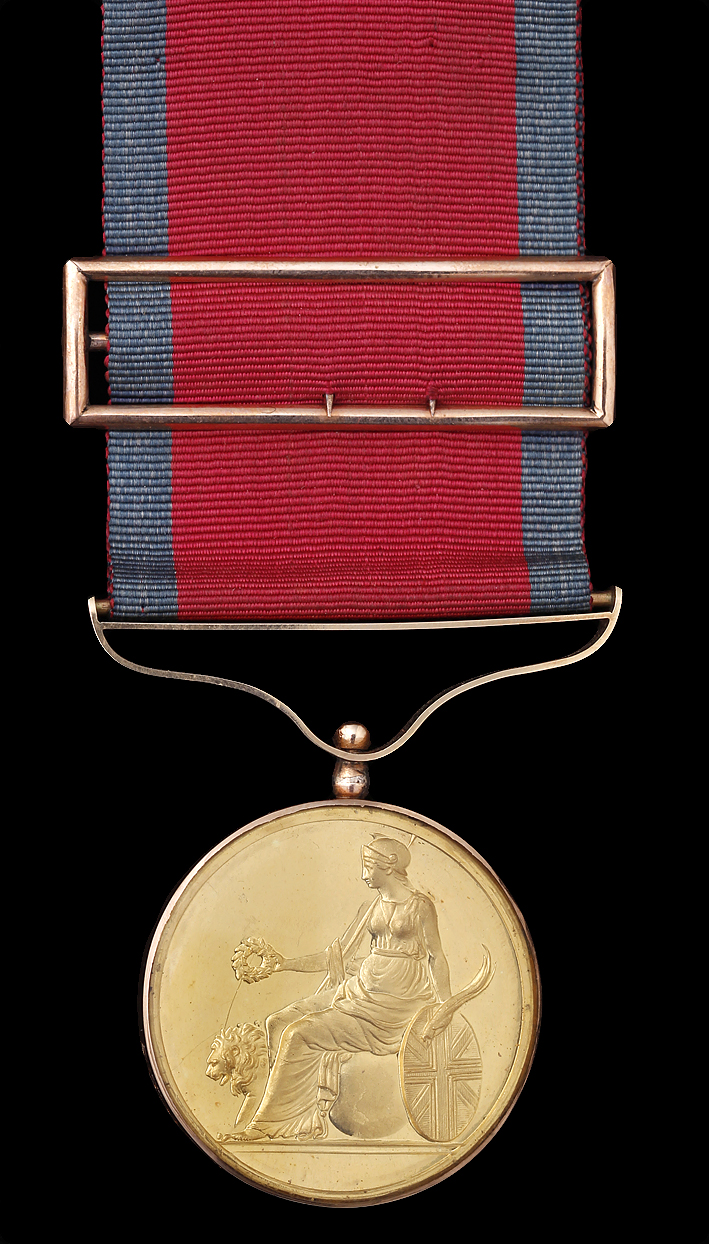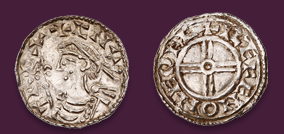
Auction: 11010 - Orders, Decorations, Campaign Medals & Militaria
Lot: 106
A Particularly Fine and Well Documented Field Officer´s Small Army Gold Medal to Lieutenant-Colonel W.L. Clowes, 3rd King´s Own Dragoons, Who Commanded a Brigade at the Battle of Salamanca, 22.7.1812 Field Officer´s Small Army Gold Medal for Salamanca (Major W.L. Clowes), good very fine, glazed in lunettes, with original gold riband buckle, and original riband, housed in a red leather Rundell Bridge & Rundell, Jewellers To Their Majesties & HRH Prince Regent, London fitted case, with the following related items: - Portrait of H.R.H. the Duke of York and Albany, signed ´Frederick, Commander in Chief´ (the signature cut from a letter to the recipient), in a glazed frame - Portrait of the Duke of Wellington, signed ´Wellington´, in a glazed frame - Journal of Campaign in Portugal and Spain 1811 & 1812, the recipient´s typed account of his time in the Peninsula, bound in red leather, the detached cover embossed in gold - Letter to the recipient from the Commander in Chief regarding the award of the Army Gold Medal, dated 21.9.1813 (the signature cut from the letter and attached to the above mentioned portrait), together with two other contemporary letters, bound in the recipient´s journal Estimate £ 12,000-16,000 Lieutenant-Colonel William Legh Clowes was born at Broughton Hall, Manchester, in March 1781, and was Commissioned Cornet, 3rd (King´s Own) Dragoons, October 1796; Promoted Lieutenant in March 1799; Captain in July 1800; and Major in April 1809, he embarked with his Regiment for the Peninsula on the 27th July 1811, disembarking at Lisbon on the 25th August. Shortly after their arrival, Lieutenant-Colonel Mundy, on account of his health, returned home, leaving the command of the Regiment in the hands of Major Clowes. After spending three months in the Peninsula without seeing any major action, Clowes rode over to Cuidad Rodrigo on the 19th January 1812 and was an eye witness to the assault of that evening, entering the town the following day ´and was much struck with the various effects of the Siege and consequences of the successful assault.´ (recipient´s diary refers). On the 28th March ´I was ordered to take the Command of a Squadron from each Regiment of the Brigade and to proceed under the orders of General Clinton with the 6th Division before daybreak to surprise the enemy at Azuaga. The enemy were appraised of our approach and retired after a little skirmishing in the direction of Fuente de Onoro. The view of the Castle of Azuaga with the two Forces, the one retiring and the other advancing, was beautifully picturesque. The Brigade remained here with an advance of two Squadrons at La Granja, in constant alertness until the 1st April when at two o´clock in the afternoon an alarm was given that the enemy were in great force and were driving in our advanced Squadrons under the command of Major Hugavin. This proved to be the case but the enemy retired before the approach of the Brigade, after having destroyed 24 men and horses in killed, wounded, and prisoners. We took 12 men and horses prisoner and killed one man.´ (ibid). On the 7th April Clowes was at Almendralejo when he heard of the surrender of Badajoz. The following day he marched with the Brigade on Albuera ´and had bivouacked in a wood and were cooking our dinners when a sudden order came for us to advance, which we did for about a league and bivouacked for the night. 11th April came up with the advanced cavalry of Drouet´s Force at Villa Garcia, which were charged by the 5th Dragoon Guards and repelled with a loss of 150 men and horses taken prisoner, besides killed and wounded. The 5th Dragoon Guards lost 20 men and 10 horses killed and wounded.´ The Brigade retired to Bien Vevida, and then onto Badajos, ´which displayed to excess all the horrors and impressions of a Siege and Assault.´ Salamanca On the 12th June the whole of the 1st Division of Cavalry was inspected by Wellington; Clowes then proceed with his Brigade at the head of the left column commanded by General Pater. After a four day march the column arrived at Salamanca. ´We were opposed by the enemy´s cavalry. The two forces remained formed opposite to each other until the evening on the 17th June, when the enemy retired into the town and we two miles to the rear to a wood where the whole Army encamped together. The next day the Army advanced towards Salamanca which they entered, the enemy having evacuated it, leaving a Garrison of 1500 men in a small but strong fort. The Regiment was quartered at Carbarizos, a small village two miles in advance of Salamanca. That evening I went into the Salamanca and procured eatables and drinkables of all sorts, of which we had previously been very short. Admired the town, most particularly the Square. The following day we remained at Carbarizos. Then on the 20th June we marched at break of day into position and at about eight o´clock saw the enemy approaching in three distinct columns which continued to collect and to approach until towards five o´clock in the afternoon when our Army advanced to its ground to receive them. General Le Marchant´s Brigade was brought forward to the front, the 5th Dragoon Guards detached to the right, and the 3rd and 4th posted in two lines and exposed to the enemy´s guns, which opened upon the King´s Own twice a most galling, and to the horses, a destructive fire. We lost eight troop horses killed, and one officer (Cooper). The men behaved wonderfully sturdy. At seven o´clock the enemy not advancing we were withdrawn to our bivouac on the open ground. The next two days we remained in our position, the enemy keeping his ground about a quarter of a mile in our front.´ (ibid). The next month Clowes was again in action, and this time was instrumental in saving the Guns of the 3rd Division: ´On the 18th July we marched at daybreak in the rear of General Alten´s Brigade towards Alaejos- we retired about noon in the direction of Carnizal and at two o´clock had received orders to bivouac and feed, when the Regiment was directed to advance in support of the Guns of the 3rd Division, and had marched for that purpose two miles to the front, when perceiving the enemy´s cavalry advancing with a superior force upon General Alten´s Brigade, consisting of the 1st Hussars and 1st and 4th Dragoons, I begged permission to send the Guns to the rear, and to advance to their support, and arrived just in time to save them from the enemy, who retired upon our approach. Throughout the day the Regiment was much exposed to the enemy´s Infantry and Artillery fire, and lost one officer, eight men, and twelve horses killed and wounded. The Regiment behaved remarkably well.´ Then, on the 22nd July, ´we advanced to support the Light Dragoons who were skirmishing on the right with the enemy´s Cavalry. At two o´clock we were ordered into a village to feed, but had scarcely arrived there when, the enemy advancing, we were ordered to retire- from this time until between five and six o´clock the enemy kept up an incessant and tremendous fire of Artillery, which did but little damage. At a quarter before six o´clock we received orders for an attack which commenced with the 3rd Division on the enemy´s left, which was turned by them in the most gallant style- we together with the centre column were then brought forward and the Brigade made a determined and effectual charge against the enemy´s Infantry, which were found in strong columns and posted on heights in a thick wood- the result of this charge was about 1400 prisoners and 7 Guns captured. Night coming on our part of the work ceased, but the Infantry made a successful pursuit of the retreating enemy, and killed and wounded many thousands.´ (ibid). Clowes was promoted Lieutenant Colonel at the start of August 1812, and on the 12th of that month he formed part of the escort as Wellington entered Madrid, where ´the joys of the inhabitants exceeded anything that could be imagined.´ Returning to England, he retired from the active list on the 15th December 1812, receiving his Gold Medal for Salamanca the following year. Lieutenant-Colonel Clowes died at home at Broughton Hall in August 1862, aged 81.
Sold for
£32,000




